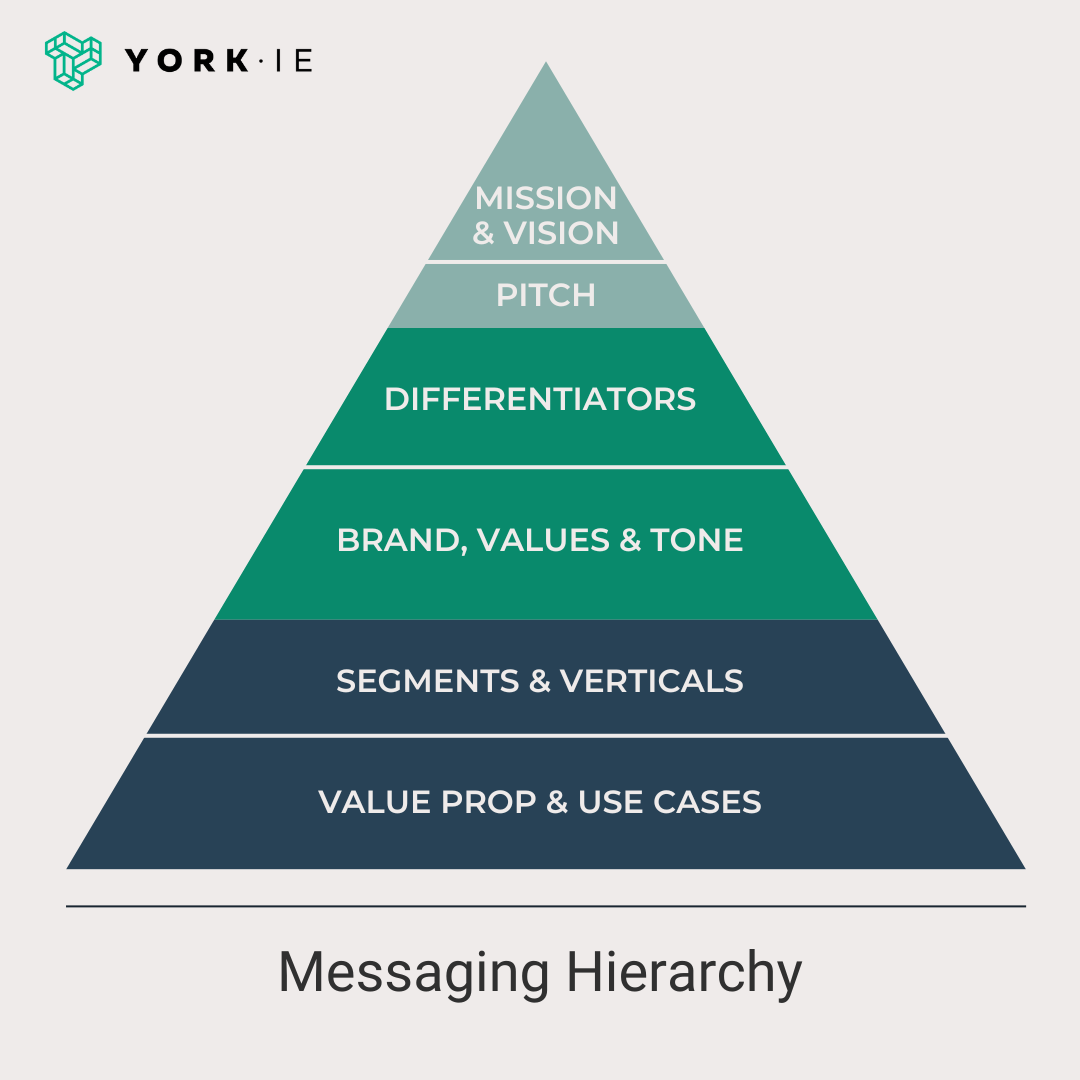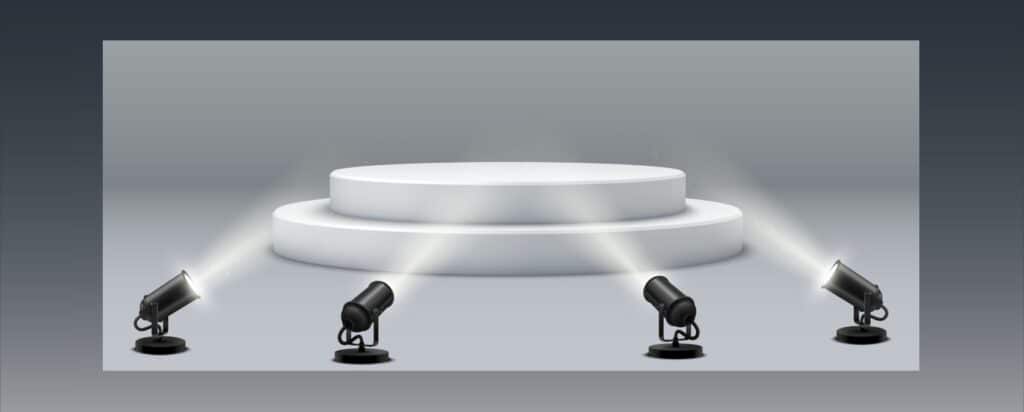Who are you? If you don’t know the answer to that question, you’ve lost before you’ve even begun. That’s why you need a messaging hierarchy as soon as you start your early-stage startup.
Messaging is the most fundamental part of marketing. There will always be new buzzwords, trends and bandwagons, but all of that is only useful if you start with a strong brand messaging framework. There is no silver bullet to cut through the noise and have your company be heard.
In this article, you’ll learn:
- What is a messaging hierarchy?
- Why is a messaging hierarchy important?
- What should be included in a messaging hierarchy?
And you’ll be able to put what you’ve learned to use in our free messaging hierarchy template.
What Is a Messaging Hierarchy?
A messaging hierarchy, also known as a brand messaging framework, is a marketing document that defines exactly what your company wants to be, do and say — and how to accomplish that in a clear, scalable and differentiated way.
At York IE, we can’t put enough emphasis on the importance of this document. It’s how we start every single engagement for our marketing and communications services clients. There is importance in writing words down and pausing before you jump into a full strategy.
Messaging boils down to a simple principle for me. It’s the why. What is your reason for existing? What are you solving for? Who needs it? Why? Why now?
It’s also about answering the hard questions: What are you not doing or chasing? Who are you not serving? What are you not trying solve for? Why? A brand messaging framework helps to capture it all in one spot.
Startups often don’t know exactly what they are. But they need to figure it out before they can tell the world. Put in the time upfront and obsess over what you are, where you want to be and who you aren’t. If you’re just chasing the latest buzzwords, your messaging ends up being a strewn tapestry of unrelated ideas that quickly becomes irrelevant.
There is nothing worse than a constantly changing message. Everyone ends up lost, and your brand never quite gets built. When you try to be everything, you end up being known for nothing.
I’ve spent years working with companies on messaging. I remember the quarterly shifts and the new pivots. They only confused audiences, wasted resources on new campaigns, created disjointed messages and — worst of all — left customers wondering exactly what they were paying for and if they even had budget for it.
You may miss the boat with your core audience if you go too broad in your messaging. But on the other hand, if you keep changing, you are never known for one thing. There is a balance, and it comes down to messaging. Starting with a hierarchy will ensure you know what you are and what you want to say so you don’t get distracted by the latest fad.
So much content can come from this, and it will come to define what you are known for in your market.
Why Is a Messaging Hierarchy Important?
A messaging hierarchy is important because it:
- creates clarity around your story
- enables scalable, consistent storytelling
- highlights your differentiators
- forms your content strategy foundation
Clarity
Creating messaging hierarchies gets thoughts out of founders’ heads and onto paper, where others can provide feedback and see the full vision. Founder-led storytelling is an important part of the startup journey, and writing it out makes the story available for all to share.
Doing so also clearly communicates the company’s core set of values to employees, customers and other audiences.
Consistency
By clearly communicating your values, it creates a foundation to ensure that everyone is saying the same thing and working towards the same great vision. It also provides a resource for employees to use consistent language across all owned channels.
Differentiation
The market-in approach — using research to inform what your unique point of view is and how you want to deliver it — is so important for brand building. Only when you know your competitors, comparators and overall market like the back of your hand can you truly define your message. If you don’t stand out from the crowd, then how can you expect your customers to notice you?
Content
Once you have your messaging and point of view, it’s all about getting it out there with a disciplined and focused content distribution strategy. From here, even with limited resources, you can do effective, consistent marketing. A strong strategy breaks up the key messages in your messaging hierarchy into multiple, diverse forms of content, such as blog posts, social media posts, videos, infographics and more.
This approach is designed for companies with little brand equity. To be honest, in today’s 24/7 connected world, no one pays as much attention to you as you do to yourself. Only when you’re sick of hearing yourself is when people start to notice.
Every day is an opportunity to build your brand!
What Should Be Included In a Messaging Hierarchy?
Your messaging hierarchy should include the following sections:
- Vision and mission
- Elevator pitch
- Key differentiators
- Brand, tone and core values
- Market segments and industry verticals
- Value proposition and use cases
1. Vision and Mission
Your vision should be aspirational, while your mission should reflect your day-to-day obsession. For example, Ikea’s vision is “to create a better everyday life,” and its mission is “to offer a wide range of well-designed, functional home furnishing products at prices so low that as many people as possible will be able to afford them.”
2. Elevator Pitch
Your elevator pitch is the overview of your company. It needs to be succinct and thoughtful and to clearly articulate your business strategy. To create yours, ask yourself the following questions:
- Who are you?
- What do you do?
- How do you do it?
- Who do you do it for?
3. Key Differentiators
Take the answers to the questions above and expand upon them, explaining how they’re different from what your competitors’ and comparators’ answers would be — and why your approach is better.
4. Brand, Tone and Core Values
Your brand is not just your name and logo. It represents what your company stands for at a high level and how it’s perceived. Your values are your company’s specific beliefs, and your tone is how you express those beliefs to your market.
5. Market Segments and Verticals
Are you targeting small and medium-size businesses or large enterprises? What industries are your potential customers in?
6. Value Proposition and Use Cases
Putting everything in the above sections together, how does your company provide value to your target customers? How specifically do those customers use your offering to realize that value?
Messaging Hierarchy Template
To start building out your brand messaging framework, download the free template from our Fuel platform.








